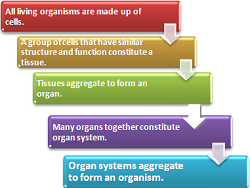Cell Structure and Functions - Revision Notes
CBSE Class 08 Science
Revision Notes
Chapter – 8
Cell — Structure and Functions
Revision Notes
Chapter – 8
Cell — Structure and Functions
- Cell: The smallest structural and functional unit of an organism, which is typically microscopic and consists of cytoplasm and a nucleus enclosed in a membrane.

- All organisms are made of smaller parts called organs.
- Organs are made of still smaller parts. The smallest living part of an organism is a ‘cell’.
- Cells were first observed in cork by Robert Hooke in 1665.
- Cells exhibit variety of shapes and sizes.
- Number of cells also varies from organism to organism.
- Some cells are big enough to be seen with the unaided eye. Hen’s egg is an example.
- Some organisms are single-celled, while others contain large number of cells.
- The single cell of unicellular organisms performs all the basic functions performed by a variety of cells in multi cellular organisms.
- The cell has three main parts, (i) the cell membrane, (ii) cytoplasm which contains smaller components called organelles, and (iii) the nucleus.
- Cell membrane: The basic component of a cell. The cytoplasm and nucleus are enclosed within cell membrane. There is an outer thick layer in cells of plants called cell wall.
- Cytoplasm: The jelly-like substance present between the cell membrane and the nucleus. Various organelles present in the cytoplasm are:
(i) Mitochondria
(ii) Plastids (present only in plant cell)
(iii) Endoplasmic reticulum (ER)
(iv) Ribosome
(v) Lysosomes
(vi) Vacuole
(vii) Golgi body
(viii) Centrosome (present only in animal cell).
- Nucleus: Nucleus is separated from cytoplasm by a nuclear membrane. It is generally spherical in the centre of the cell.
- Nuclear membrane: Nucleus is separated from the cytoplasm by a membrane called the nuclear membrane.
- Nucleolus: Nucleus contains a still smaller round body known as nucleolus.
- Chromosomes: Nucleus contains thread-like structures called chromosomes. These carry genes and help in inheritance or transfer of character from the parents to the off springs
- Cells without well organised nucleus, i.e. lacking nuclear membrane, are called prokaryotic cells.
- Plant cells differ from animal cells in having an additional layer around the cell membrane termed cell wall.
- Coloured bodies called plastids are found in the plant cells only. Green plastids containing chlorophyll are called chloroplasts.
- Plant cell has a big central vacuole unlike a number of small vacuoles in animal cells.
- Size of cells: The size may be as small as a millionths of a metre or may be as large as a few centimetres. Size of the cells has no relation with the size of the body of the animal or plant. It is related to its function.
